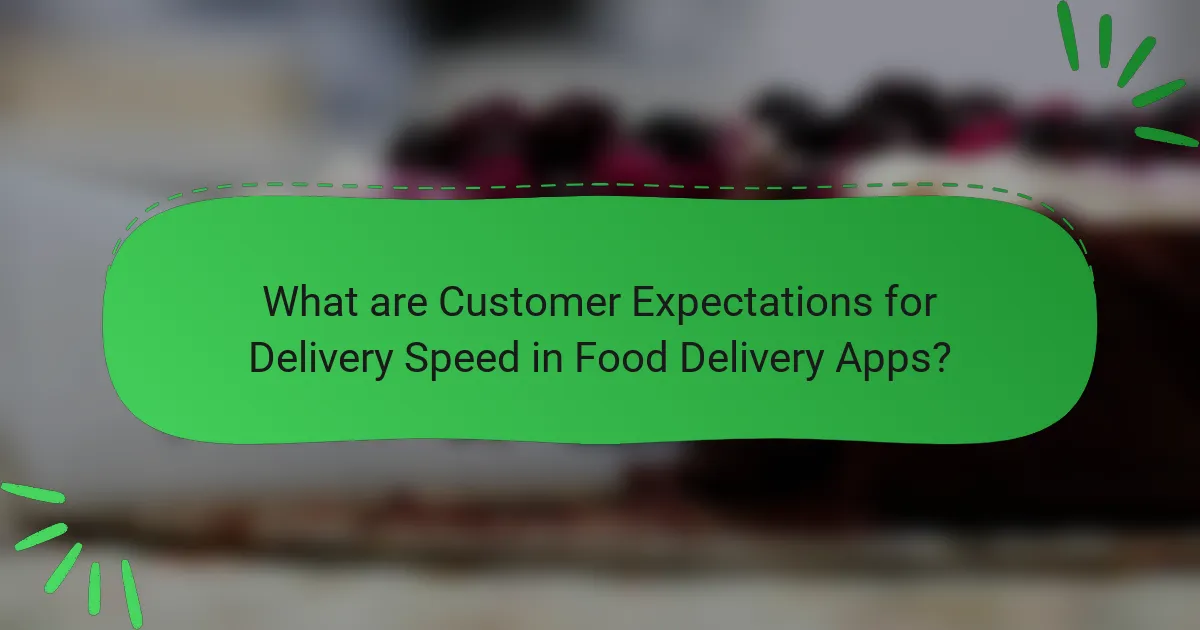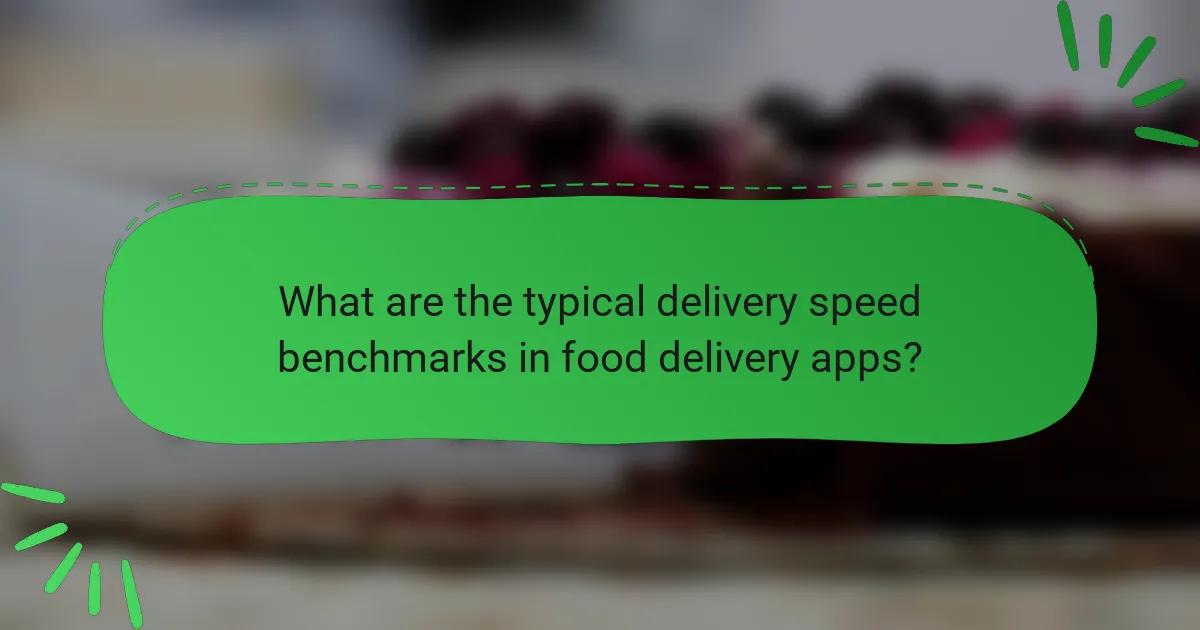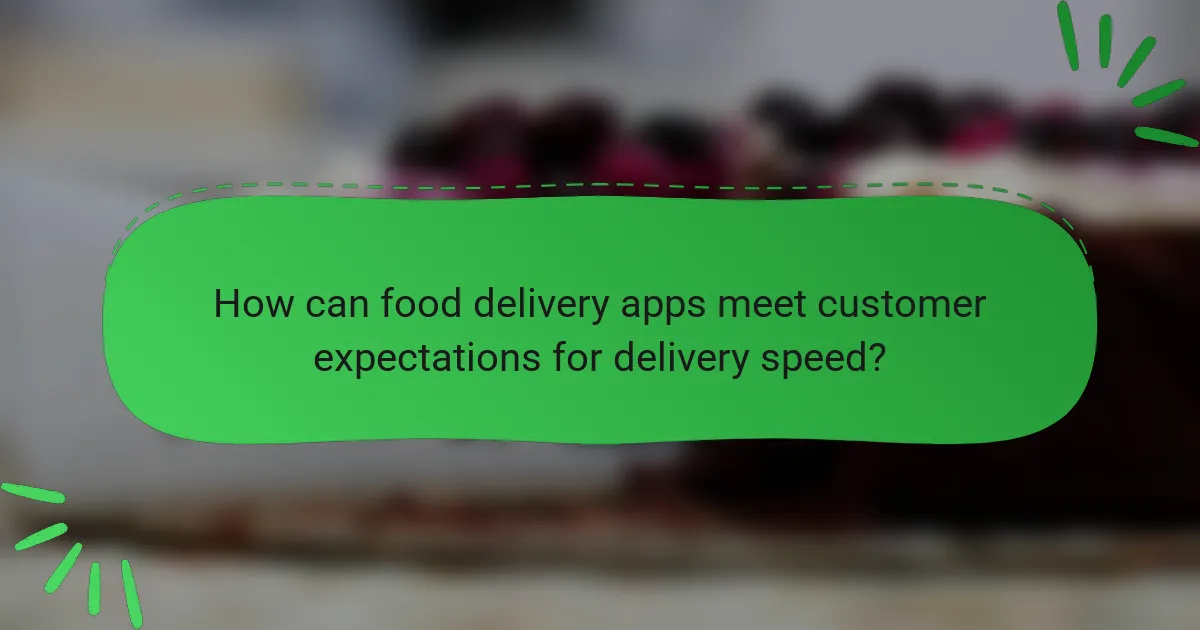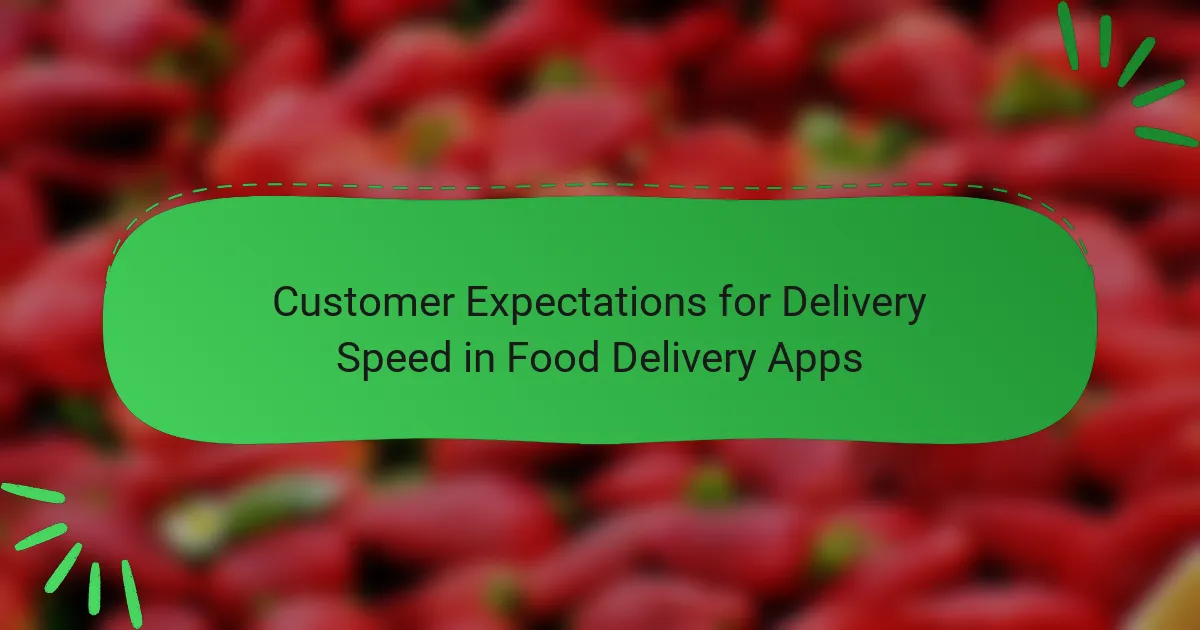Food delivery apps are increasingly expected to deliver orders quickly, with customers anticipating delivery times ranging from 30 minutes to an hour. Research indicates that 60% of customers prefer their food to arrive within 30 minutes, and delays can lead to dissatisfaction and decreased loyalty. The article explores the significance of delivery speed as a key factor influencing customer satisfaction and repeat usage. It discusses strategies that food delivery apps can employ, such as optimizing logistics, implementing real-time tracking, and utilizing efficient routing algorithms, to meet and exceed customer expectations regarding delivery times.

What are Customer Expectations for Delivery Speed in Food Delivery Apps?
Customers expect fast delivery speeds from food delivery apps. Typically, they anticipate delivery within 30 minutes to an hour. A survey by Statista indicates that 60% of customers prefer delivery within 30 minutes. Speed is a crucial factor influencing customer satisfaction and repeat usage. Delays can lead to negative experiences and reduced loyalty. Additionally, customers often track their orders in real-time. This transparency can enhance their perception of service efficiency. Overall, delivery speed is a key expectation that significantly impacts customer choices in food delivery apps.
How do customer expectations shape the food delivery industry?
Customer expectations significantly shape the food delivery industry by influencing service standards and operational strategies. High expectations for delivery speed compel companies to optimize logistics and reduce wait times. Research indicates that 60% of consumers expect food delivery within 30 minutes. This demand drives restaurants and delivery services to implement advanced tracking systems and efficient routing algorithms. Additionally, customer feedback on delivery experiences shapes menu offerings and service enhancements. As a result, businesses that fail to meet these expectations risk losing customers to competitors who prioritize speed and reliability.
What factors influence customer expectations for delivery speed?
Customer expectations for delivery speed are influenced by several key factors. These include prior experiences with delivery services, the type of food ordered, and the time of day. Fast delivery times set by competitors can also shape expectations. Customers often expect quicker deliveries during peak hours due to increased demand. Additionally, promotional offers may create a perception of expedited service. The geographic location of the restaurant and customer can affect delivery time as well. Finally, real-time tracking features can enhance customer expectations by providing transparency about delivery status.
How do cultural differences affect delivery speed expectations?
Cultural differences significantly influence delivery speed expectations. In cultures that prioritize efficiency, such as in Germany or the United States, customers expect fast delivery times. They often anticipate delivery within 30 to 60 minutes. Conversely, in cultures where patience is valued, such as in some Asian countries, longer delivery times may be acceptable. Research indicates that these cultural attitudes shape consumer behavior and expectations regarding service speed. For instance, a study by Hofstede Insights highlights how uncertainty avoidance affects customer expectations across different cultures. Understanding these differences is crucial for businesses to tailor their delivery services effectively.
Why is delivery speed a critical factor for customer satisfaction?
Delivery speed is a critical factor for customer satisfaction because it directly impacts the overall experience. Fast delivery meets customer expectations and enhances convenience. Research shows that 61% of consumers prioritize quick delivery when choosing a food delivery service. Customers associate speed with reliability and efficiency. Delays can lead to frustration and dissatisfaction. A study by McKinsey found that companies with faster delivery times see higher customer retention rates. In summary, timely delivery is essential for maintaining customer loyalty and positive brand perception.
What role does delivery speed play in customer retention?
Delivery speed is crucial for customer retention in food delivery apps. Fast delivery meets customer expectations and enhances satisfaction. Research indicates that 61% of customers are likely to return if their order arrives quickly. Conversely, delays can lead to frustration and loss of trust. A study by McKinsey shows that 70% of consumers consider delivery speed a key factor in their purchasing decisions. Therefore, improving delivery speed can directly increase repeat business and customer loyalty.
How does delivery speed impact customer reviews and ratings?
Delivery speed significantly impacts customer reviews and ratings. Faster delivery often leads to higher customer satisfaction. When customers receive their orders promptly, they are more likely to leave positive feedback. A study by McKinsey & Company found that 70% of consumers rate delivery speed as a key factor in their overall satisfaction. Conversely, slow delivery can result in negative reviews. Customers may express frustration over delays, which can lower ratings. Research from the Journal of Business Research indicates that timely delivery correlates with increased customer loyalty. Thus, delivery speed is a critical component influencing customer perceptions and evaluations.

What are the typical delivery speed benchmarks in food delivery apps?
Typical delivery speed benchmarks in food delivery apps range from 30 to 60 minutes. Many customers expect their orders to arrive within this timeframe. Research indicates that 60% of users prefer delivery within 30 minutes. A study by Statista found that 40% of consumers expect food delivery within 20 minutes. Delays beyond 60 minutes can lead to dissatisfaction. Fast food chains often aim for quicker delivery times to meet customer expectations. Overall, speed is a critical factor influencing user satisfaction in food delivery services.
How do different food delivery apps compare in terms of delivery speed?
Delivery speed varies significantly among food delivery apps. Apps like DoorDash and Uber Eats typically deliver within 30 minutes. Grubhub may take slightly longer, averaging around 35-40 minutes. Postmates often falls within a similar range as Grubhub. Factors affecting delivery speed include restaurant location, order complexity, and traffic conditions. A study by Statista found that 40% of users expect delivery within 30 minutes. Additionally, customer reviews often highlight delivery speed as a crucial factor in app satisfaction.
What are the average delivery times for popular food delivery apps?
The average delivery times for popular food delivery apps range from 30 to 60 minutes. For example, Uber Eats typically delivers within 30 to 40 minutes. DoorDash averages around 35 to 45 minutes for delivery. Grubhub’s delivery time averages between 40 to 50 minutes. Postmates usually falls within a similar range of 30 to 60 minutes. These times can vary based on factors such as location, order volume, and restaurant preparation time.
How do peak hours affect delivery speed across different platforms?
Peak hours significantly slow delivery speed across different platforms. During these times, demand for deliveries increases sharply. This surge often leads to longer wait times for customers. For example, a study by the University of California found that delivery times can increase by up to 30% during peak hours. Delivery drivers may face traffic congestion and difficulty finding parking. Additionally, food preparation times can extend due to high order volumes. Platforms may also experience system overloads, causing delays in order processing. Consequently, customer satisfaction can decrease during these busy periods.
What are the implications of fast versus slow delivery speeds?
Fast delivery speeds enhance customer satisfaction and increase repeat purchases. Customers expect their food to arrive quickly, often within 30 minutes. Research shows that 60% of consumers prefer delivery within this timeframe. Slow delivery speeds can lead to dissatisfaction and increased order cancellations. Customers may perceive delays as a lack of reliability. This perception can damage brand reputation and customer loyalty. A survey indicated that 40% of customers would choose a competitor for faster delivery. Ultimately, delivery speed significantly impacts customer retention and brand competitiveness in the food delivery market.
How does fast delivery influence customer loyalty?
Fast delivery significantly enhances customer loyalty. Customers value timely service and often choose brands that meet their delivery expectations. Research shows that 88% of consumers are less likely to return to a business after a bad delivery experience. Fast delivery creates a positive impression and builds trust in the brand. This trust leads to repeat purchases and long-term loyalty. Additionally, satisfied customers are more likely to recommend the service to others. Fast delivery can therefore be a competitive advantage in the food delivery market.
What are the potential downsides of prioritizing speed over quality?
Prioritizing speed over quality can lead to several potential downsides. First, customers may receive subpar products, negatively impacting their satisfaction. Fast delivery might compromise food freshness, affecting taste and safety. Additionally, rushed processes can increase errors in orders, leading to customer frustration. Over time, this can damage the brand’s reputation. Studies show that 70% of customers prioritize quality over speed when choosing food delivery services. This indicates a clear preference for quality, suggesting that neglecting it can result in loss of repeat business. Ultimately, businesses must balance speed and quality to meet customer expectations effectively.

How can food delivery apps meet customer expectations for delivery speed?
Food delivery apps can meet customer expectations for delivery speed by optimizing their logistics and operational processes. They can implement real-time tracking features to provide customers with accurate updates. Efficient routing algorithms can minimize delivery times by finding the quickest paths. Partnering with local restaurants can reduce wait times for food preparation. Utilizing a network of delivery personnel ensures that orders are assigned quickly. Offering incentives for faster delivery can motivate drivers to prioritize speed. Data analytics can identify peak times and adjust resources accordingly. These strategies enhance customer satisfaction by consistently meeting or exceeding delivery time expectations.
What strategies can be implemented to improve delivery speed?
Implementing real-time tracking can significantly improve delivery speed. This allows customers to monitor their orders and reduces uncertainty. Utilizing route optimization software enhances delivery efficiency. It calculates the fastest routes, minimizing delays. Employing a network of local delivery partners increases coverage and reduces distance. This strategy shortens delivery times by leveraging nearby resources. Additionally, offering multiple delivery options caters to customer preferences. Options like express delivery can meet urgent requests. Training delivery personnel on best practices ensures that they are efficient and reliable. Research shows that companies using these strategies see a reduction in delivery times by up to 30%.
How can technology enhance delivery speed in food delivery apps?
Technology can enhance delivery speed in food delivery apps through optimization algorithms and real-time tracking. Optimization algorithms improve route planning by analyzing traffic patterns and distances. This allows delivery drivers to take the fastest routes available. Real-time tracking provides accurate updates to customers about their order status. It also enables drivers to receive instant notifications about changes in delivery conditions. Additionally, automated dispatch systems assign orders to the nearest available drivers. This minimizes wait times and maximizes efficiency. According to a study by Statista, 70% of customers expect delivery within 30 minutes. Faster delivery times can significantly improve customer satisfaction and retention.
What role do delivery personnel play in meeting speed expectations?
Delivery personnel are crucial in meeting speed expectations for food delivery. They directly influence the time it takes for orders to reach customers. Efficient delivery personnel ensure timely pickups from restaurants. They navigate routes effectively to minimize delays. Their ability to adapt to traffic conditions impacts delivery speed. Studies show that faster delivery times enhance customer satisfaction. For instance, a report by McKinsey indicates that delivery speed is a key factor in customer retention. Thus, delivery personnel play a vital role in fulfilling customer speed expectations.
What best practices should food delivery apps adopt for optimal delivery speed?
Food delivery apps should adopt real-time tracking and efficient route optimization for optimal delivery speed. Real-time tracking keeps customers informed about their order status. This transparency enhances customer satisfaction. Efficient route optimization minimizes delivery time. Algorithms can analyze traffic patterns to suggest the fastest routes. Additionally, maintaining a well-trained delivery workforce is crucial. A skilled team can navigate efficiently and handle deliveries promptly. Implementing a robust communication system between customers and delivery personnel is also essential. This allows for quick updates and problem resolution. These practices collectively improve delivery speed and meet customer expectations effectively.
How can customer feedback be used to improve delivery speed?
Customer feedback can be used to improve delivery speed by identifying specific areas of delay. Analyzing feedback helps pinpoint common complaints about delivery times. This data allows businesses to streamline processes that cause slowdowns. For instance, if customers frequently mention late deliveries, companies can investigate their logistics. Implementing changes based on feedback can reduce wait times. Additionally, feedback can highlight issues with order accuracy that lead to delays. By addressing these concerns, companies can enhance overall efficiency. Research shows that companies using customer feedback effectively can see a 10-15% improvement in delivery times.
What are common pitfalls to avoid when trying to enhance delivery speed?
Common pitfalls to avoid when trying to enhance delivery speed include neglecting proper route planning. Poor route optimization can lead to longer delivery times. Another pitfall is underestimating delivery personnel training. Inadequately trained staff may struggle with efficient navigation or customer service. Additionally, failing to invest in technology can hinder speed enhancements. Lack of real-time tracking systems may result in delays and miscommunication. Overpromising delivery times without capacity to meet them can damage customer trust. Lastly, not analyzing performance data prevents identifying bottlenecks in the delivery process. Addressing these pitfalls is essential for improving delivery speed effectively.
What tips can customers follow to ensure faster delivery experiences?
To ensure faster delivery experiences, customers should place their orders during off-peak hours. This reduces wait times as fewer orders are being processed. Customers should also provide accurate delivery information, including specific addresses and any necessary access instructions. Clear communication helps delivery personnel locate the destination quickly. Choosing express delivery options can further expedite the process. Many food delivery apps offer this service for an additional fee. Customers should track their orders in real-time to stay updated on delivery status. This allows them to be prepared for arrival. Additionally, selecting a restaurant that is closer to their location can significantly reduce delivery time. According to a study by the Journal of Business Research, proximity to the restaurant correlates with shorter delivery times. Finally, tipping well can encourage faster service from delivery drivers.
The main entity of this article is customer expectations for delivery speed in food delivery apps. It explores how customers typically anticipate delivery within 30 minutes to an hour, with 60% preferring delivery within 30 minutes, highlighting the critical role of speed in customer satisfaction and retention. The article discusses various factors influencing these expectations, including prior experiences, cultural differences, and peak times, as well as the implications of fast versus slow delivery speeds on customer loyalty and brand reputation. Additionally, it outlines strategies for food delivery apps to enhance delivery speed, such as optimizing logistics, utilizing technology, and leveraging customer feedback.
